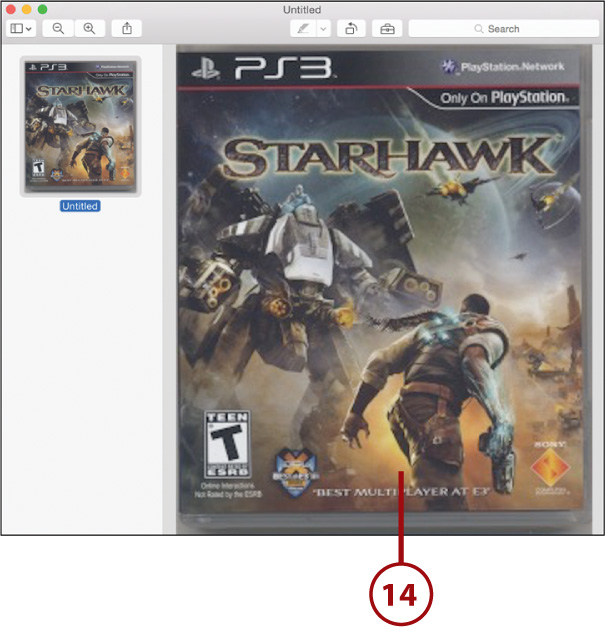13. Connecting Peripherals to Your Mac

In this chapter, you find out how to connect devices to your Mac and immediately expand your system’s capabilities, including:
![]() Adding a keyboard and mouse
Adding a keyboard and mouse
![]() Pairing Bluetooth devices
Pairing Bluetooth devices
![]() Connecting and configuring external displays
Connecting and configuring external displays
![]() Sending video and audio to an Apple TV
Sending video and audio to an Apple TV
![]() Adding and using printers
Adding and using printers
![]() Accessing and using popular scanners
Accessing and using popular scanners
The Mac comes with everything you need to get started using the system, but that doesn’t mean that you can’t expand it. Your Mac can interface with many different devices—frequently without requiring any additional software to be installed.
In this chapter we look at the different types of peripherals that work with your Mac out-of-the-box.
Connecting USB Input Devices
The Mac can connect to a variety of devices using the standard USB (Universal Serial Bus) ports located on the back. This section walks you through connecting a generic keyboard and mouse. Keep in mind, though, that there are hundreds of different input devices.
You should always refer to the documentation that came with your device. If the manual doesn’t mention the Macintosh (such as for a Windows-specific keyboard), try plugging in the device to see what happens!
The USB standard includes a variety of different profiles that define how a device can be used (input, audio output/input, and so on). These standards are supported on both Macintosh and Windows platforms. Just because a device does not specifically say it supports the Mac, doesn’t mean that it won’t work anyway.
Configuring a USB Keyboard
Your Mac comes with a perfectly usable keyboard, but if you have a favorite wired keyboard, you can plug it in and start using it almost immediately. To use a standard USB keyboard with your Mac, follow these steps:
1. Plug the keyboard into a free port on your Mac (not pictured).
2. If the keyboard is an Apple or Mac-specific keyboard, it is recognized and immediately usable (not pictured).
3. If you are using a generic USB keyboard, the Keyboard Setup Assistant launches and you are asked to identify the keyboard. Click Continue.
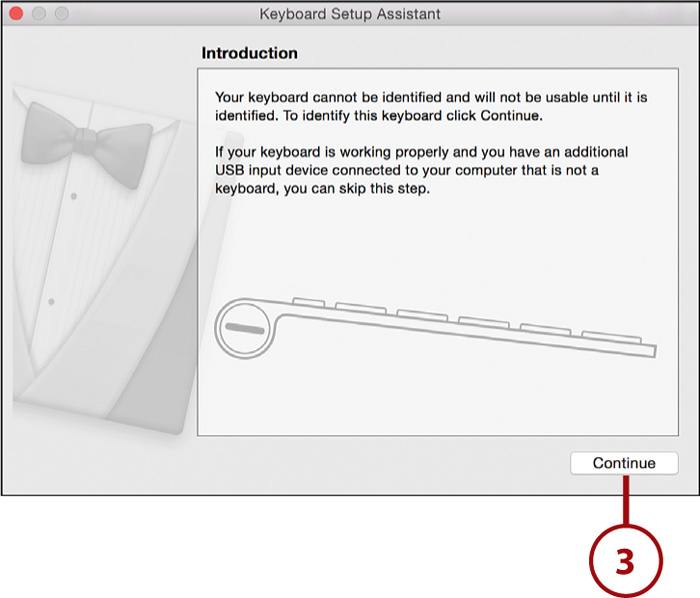
4. Walk through the steps presented by the setup assistant, pressing the keyboard keys when requested. If the assistant can’t identify the keyboard, you are asked to manually identify it.
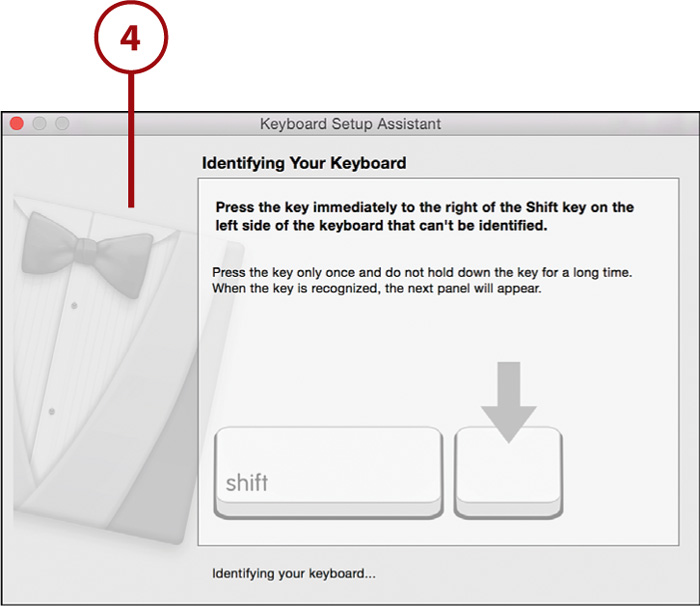
5. Click Done at the conclusion of the setup assistant. The keyboard setup is complete, and the keyboard is ready to be used.
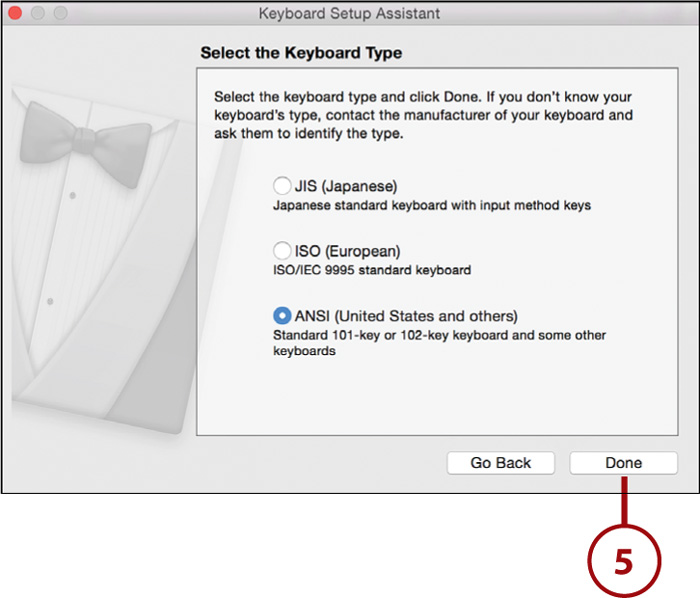
Manually Configuring the Keyboard Type
If the setup assistant does not start automatically when you plug in a USB keyboard, you can start it by opening the System Preferences window and clicking the Keyboard icon. In the Keyboard panel, click Change Keyboard Type.
Configuring a USB Mouse
The Apple mouse is nice, but some of us like options! Want to use a shiny USB mouse with a zillion buttons? No problem. Like keyboards, USB mice plug right in and start working in a matter of seconds.
1. Open the System Preferences and click the Mouse icon.
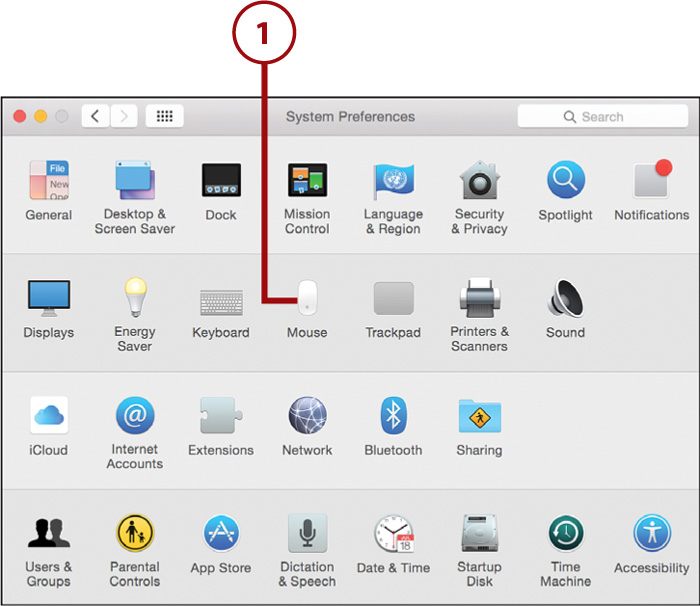
2. Plug a USB mouse into your Mac (not pictured).
3. After a few seconds the Mouse panel updates to show the available options for your device.
4. Uncheck Scroll Direction: Natural if you prefer a scroll wheel that behaves in a traditional manner (down to go up, and vice versa).
5. Adjust the Tracking Speed, Scrolling Speed (if the mouse includes a scroll wheel), and Double-Click Speed by dragging the sliders left or right.
6. Choose which button acts as the primary button.
7. Close the System Preferences panel when you’ve finished your configuration.
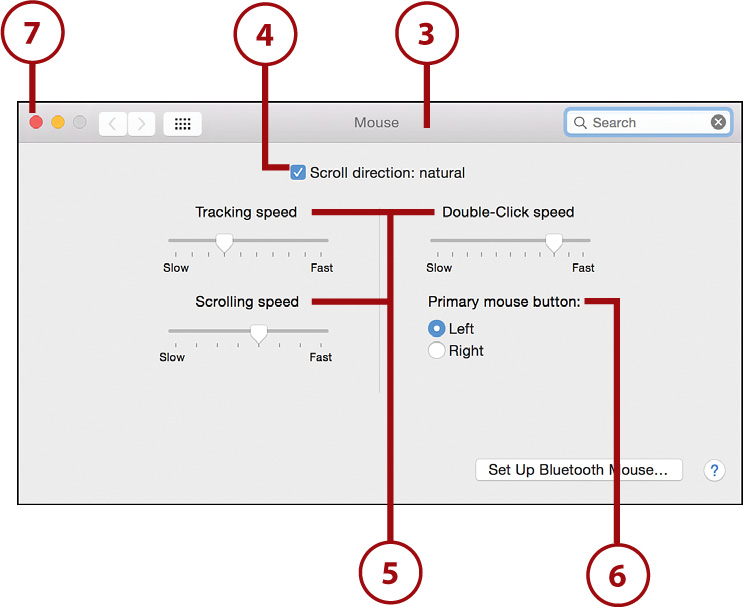
Using Bluetooth Devices
The Mac’s built-in Bluetooth enables it to wirelessly connect to a variety of peripheral devices, including keyboards, mice, headsets, and so on. As with USB peripherals, your first step toward installing a device is to read the manufacturer’s instructions and install any drivers that it came with.
After installing the software that came with the peripheral, you use the Apple Bluetooth System Preferences panel to choose and pair your device.
Pairing a Bluetooth Mouse or Trackpad
To pair a Bluetooth device with your Mac, you follow the same basic steps, regardless of the type of peripheral. This task’s screenshots show an Apple Magic Trackpad being paired with the Mac.
1. Open the Bluetooth System Preferences panel.
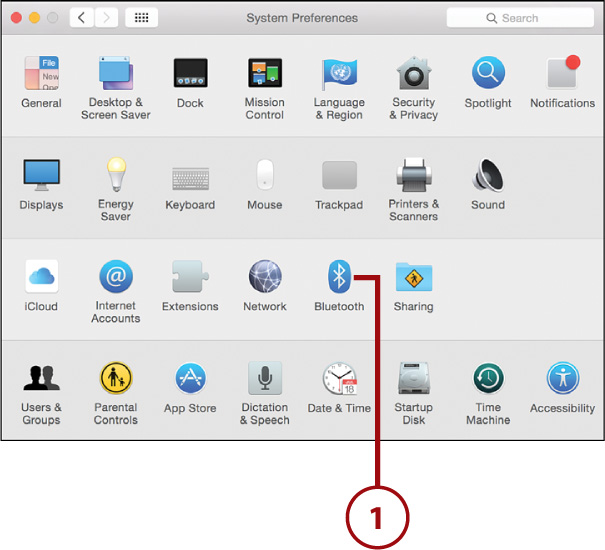
2. Make sure that your Mac’s Bluetooth system is On.
3. Devices that are paired with your Mac are shown at the top of the list on the left, and new devices are shown at the bottom.
4. Click Pair to pair a new mouse or trackpad with your Mac.
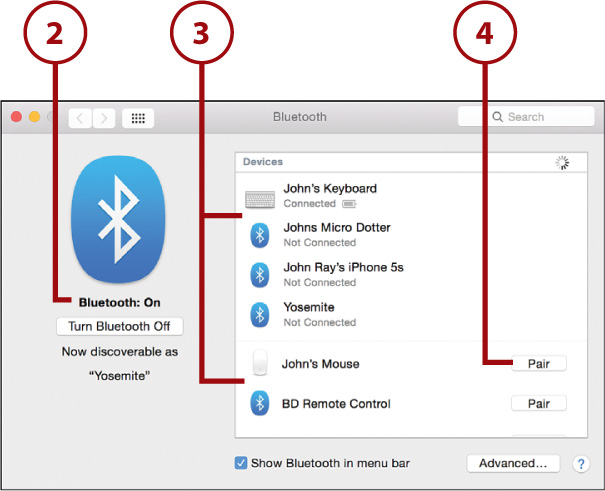
5. After a few seconds, the device is paired and available.
6. Click the X beside a device in the list to remove the pairing at any time.
7. Close the System Preferences when finished.
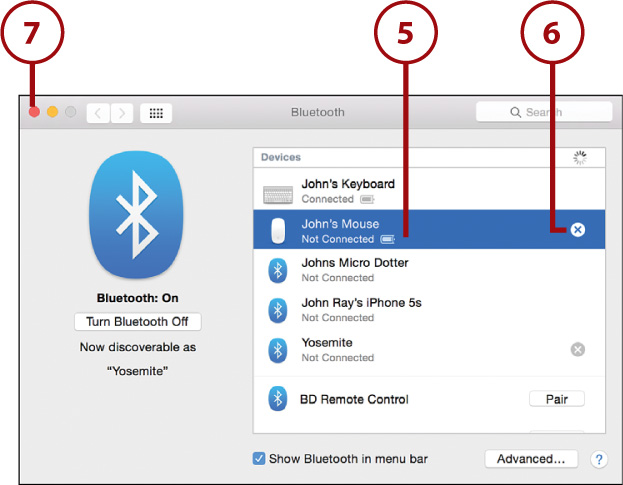
Setting Up Bluetooth Devices from Almost Anywhere
You might notice that there is a Set Up Bluetooth [Keyboard, Mouse, Trackpad] option within the keyboard, mouse, and trackpad system preferences panels. You can use these as shortcuts to immediately start searching for a Bluetooth device of that type. The Bluetooth System Preferences panel, however, is the central point for pairing all devices.
8. Your new device is listed in the Bluetooth System Preferences panel (not shown).
9. Use the corresponding (Mouse/Trackpad) Preferences panel to configure your device.
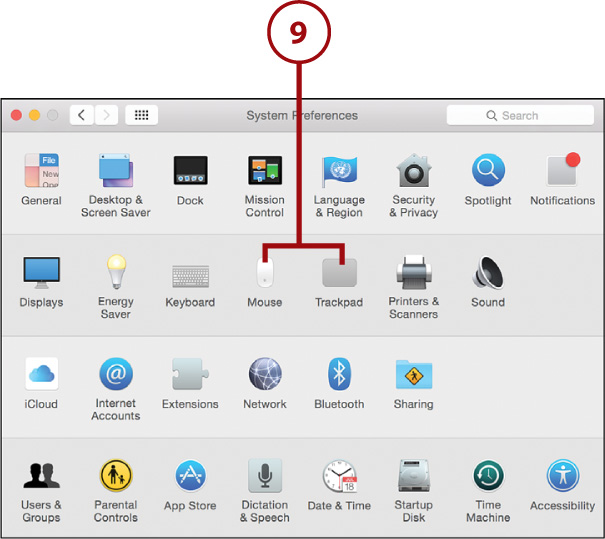
When you’re using an Apple Bluetooth device or keyboard, the corresponding preferences panels display battery status for the devices. You can also monitor battery status by adding the Bluetooth status to your menu bar by selecting Show Bluetooth Status in Menu Bar in the Bluetooth System Preferences panel.
Pairing a Bluetooth Keyboard
Some Bluetooth devices, such as keyboards, require an additional step while pairing: the entry of a passkey on the device you are pairing with. To pair a keyboard with your system, follow these steps:
1. Follow steps 1–5 of the “Pairing a Bluetooth Mouse or Trackpad” task, selecting the keyboard device from the list of detected devices, then clicking Pair.
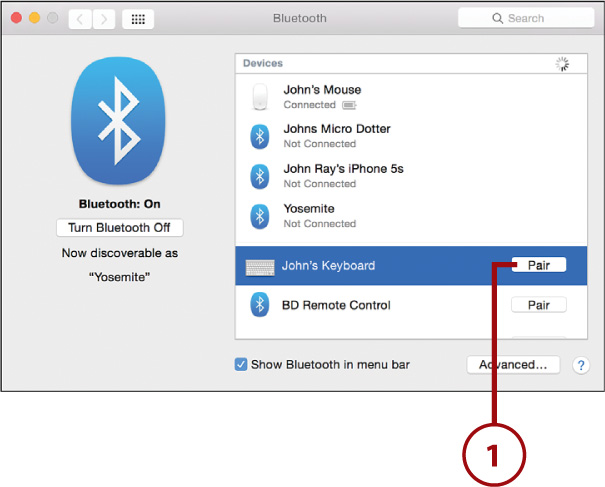
2. The setup process prompts you to enter a passkey on your device. Type the characters exactly as displayed on screen, including pressing Return, if shown.
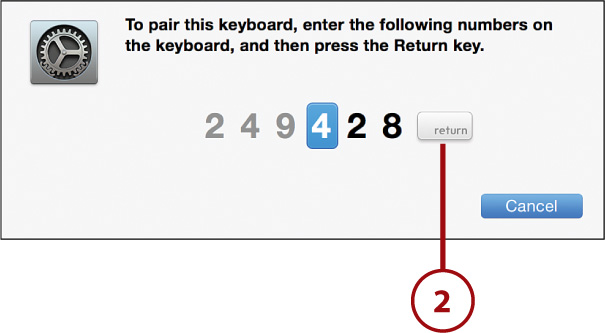
3. If the passkey was successfully entered, the device is configured and paired.

4. Open the Keyboard Preferences panel and configure the device as described in Chapter 11’s section “Updating Keyboard and Dictation Settings.”

Dealing with Troublesome Passkeys
If, for some reason, you enter the passkey and get an error, look for a Passcode Options button in the lower-left corner of the window during setup. Clicking this button might allow you to bypass the passkey or choose one that is easier to enter on your device.
Connecting a Bluetooth Headset
Wireless headphones and headsets can help untether us from our computers when conferencing or listening to music. Your Mac with Yosemite supports high-quality audio over Bluetooth connections, and setup is a cinch:
1. Follow steps 1–5 of the “Pairing a Bluetooth Mouse or Trackpad” task, selecting the headset device from the list of detected devices, then clicking Pair.
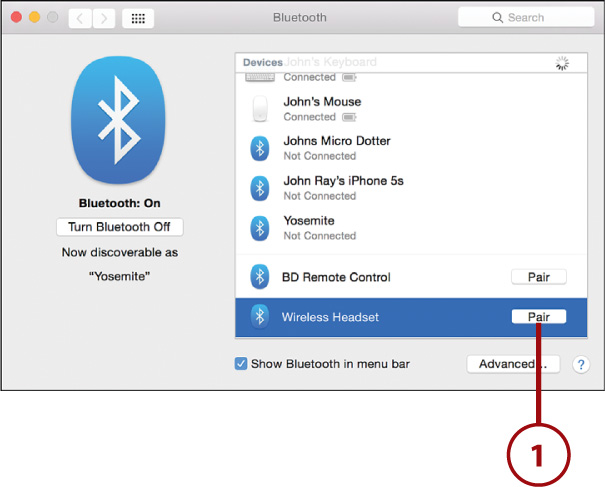
2. The headset is added to your system. You might need to cycle the power on and off the headset before it will work, however.
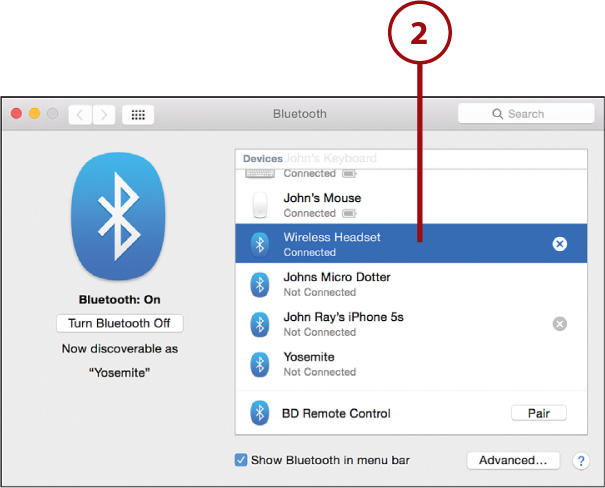
3. To set the headset for audio input or output, use the Sound System Preferences panel, as described in the Chapter 11 section, “Setting Sound Input and Output.”
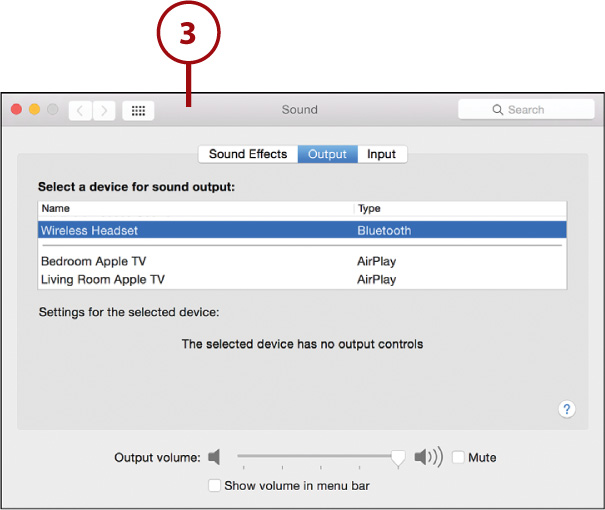
Adding and Using the Bluetooth Status Menu
Apple Bluetooth devices report their status directly to your computer, giving you a heads up on battery issues and other status problems. To use the Bluetooth status menu, follow these steps.
1. Open the System Preferences window and click the Bluetooth icon.

2. Click the Show Bluetooth in Menu Bar checkbox.
3. Close the System Preferences.
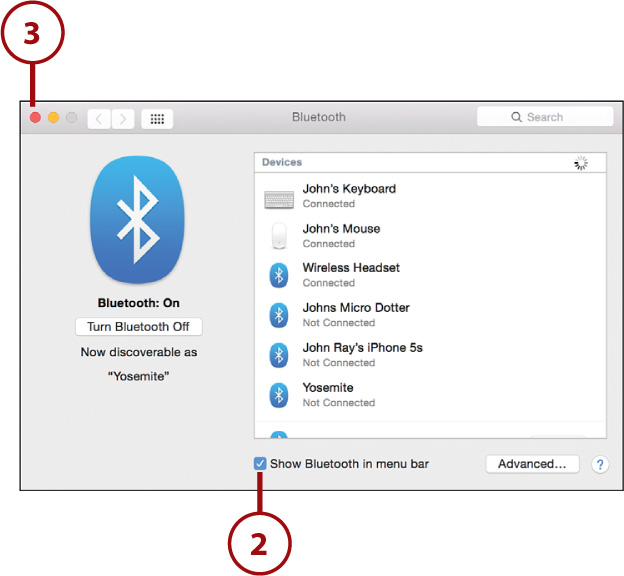
4. The Bluetooth menu is added to your display.
5. Each paired device has an entry in the menu for quick control of its features and display of battery levels (Apple devices only).
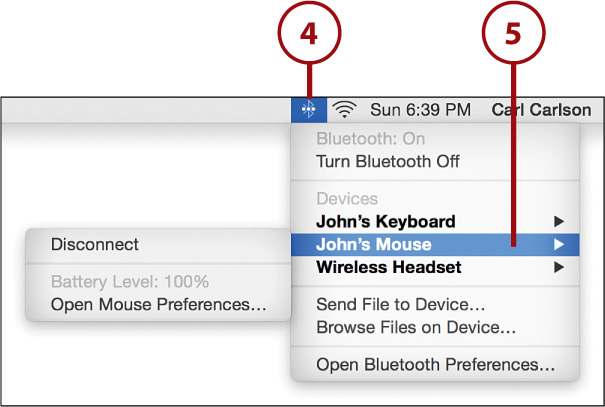
Using External Displays and Projectors
Even the smallest Macintosh screens are larger than the biggest monitors we had a decade ago, yet somehow we manage to fill them. As I’m sure you’ve encountered, there are times when using an external monitor or a projector is helpful. As long as you have the right cables, running an external monitor is plug-and-play—no rebooting required.
What Kind of External Displays Can I Run?
All modern Macs have Thunderbolt or a Mini DisplayPort video output, which can be adapted to VGA or DVI output with a plug-in dongle from Apple. Earlier models used a miniDVI port, which, similarly, could be output to VGA or DVI monitors with the appropriate adapter.
Extending Your Desktop to Another Monitor
To use another monitor to extend your desktop, follow these steps:
1. Plug the monitor into your Mac using the appropriate adapter cable (not shown).
2. The monitor is initialized and displays your desktop at the highest resolution (not shown).
3. Open the Displays System Preferences panel.
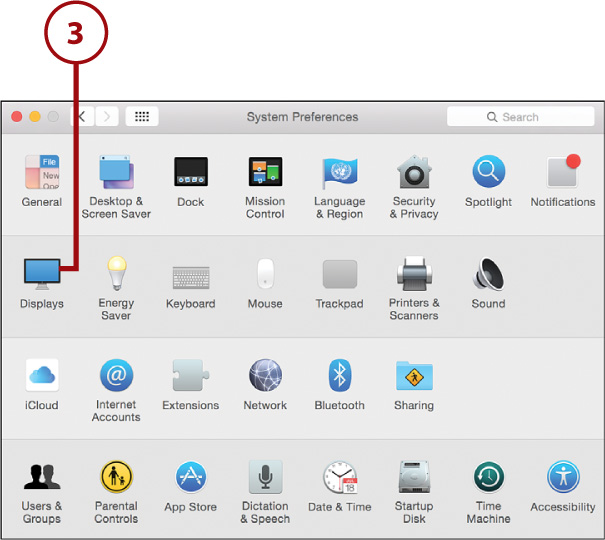
4. A unique window is shown on each connected monitor, enabling you to customize its characteristics.
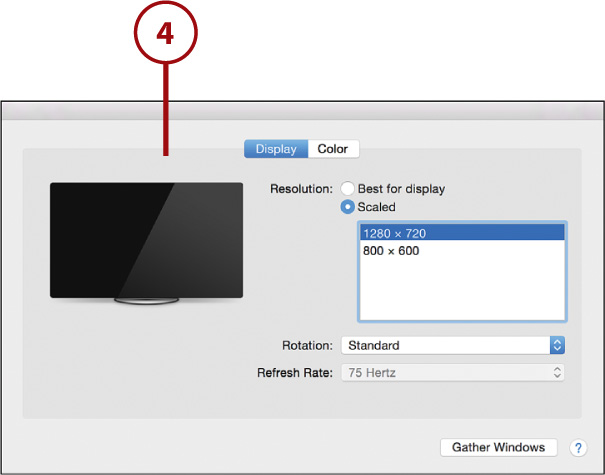
5. Close the System Preferences (not shown).
Setting Monitor Arrangements
After a monitor has been connected to your system, you can choose how it is arranged in relationship to your Mac display and whether or not it displays the menu bar.
1. Open the Displays System Preferences panel.
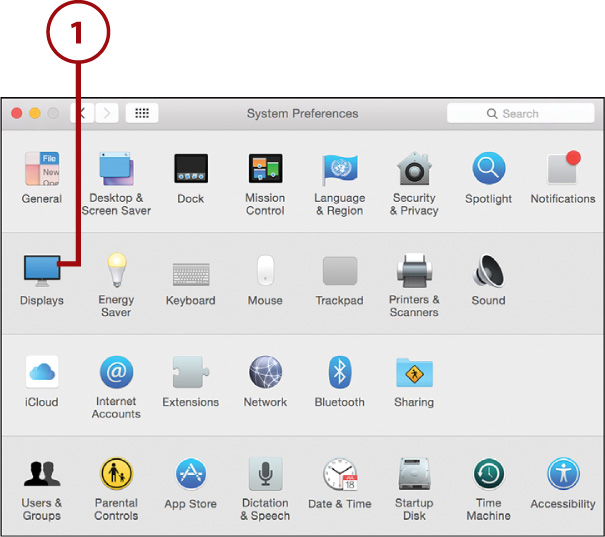
2. Click the Arrangement button at the top of the window.
3. Drag the visual representation of the monitors so that it best represents your physical setup (that is, external monitor on the left, right, above, and so on).
4. If you want, change your primary display by dragging the small white line representing the menu bar from one display to the other.
5. Close the System Preferences.
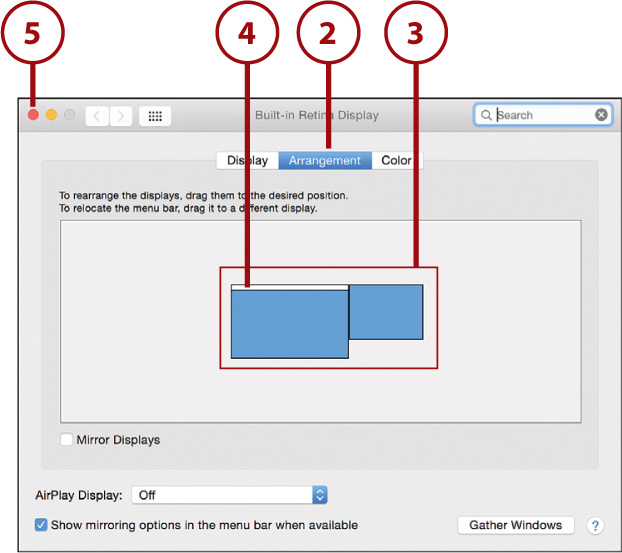
Adding the Display Mirroring Menu to Your Menu Bar
If you frequently want to mirror your display (rather than extend your desktop), or display content on an Apple TV, you can either use the Displays System Preferences panel or add a global “mirroring” menu to the menu bar.
1. Open the Displays System Preferences panel.
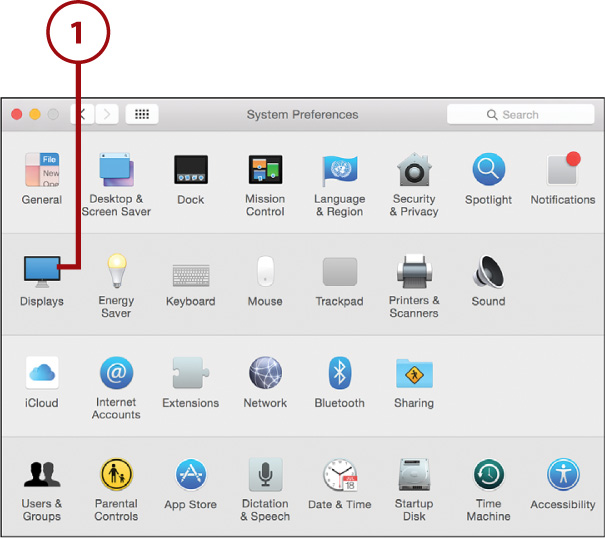
2. Click the Show Mirroring Options in Menu Bar When Available checkbox.
3. Close the System Preferences.
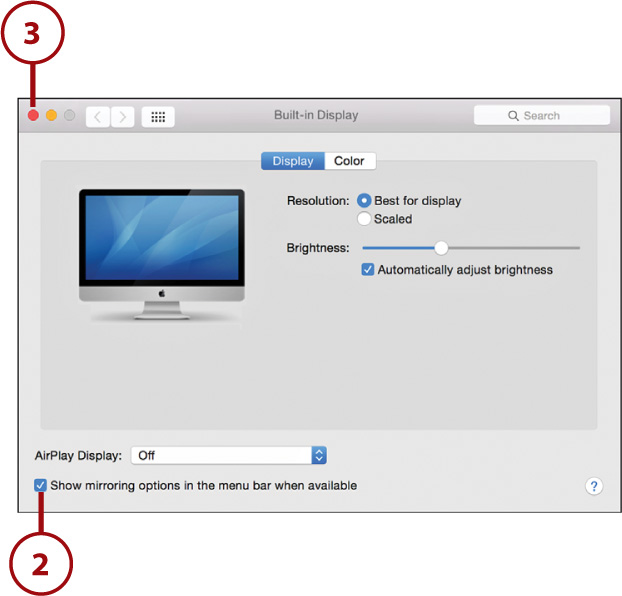
4. The menu item appears when external displays (or Apple TVs) are available to use.
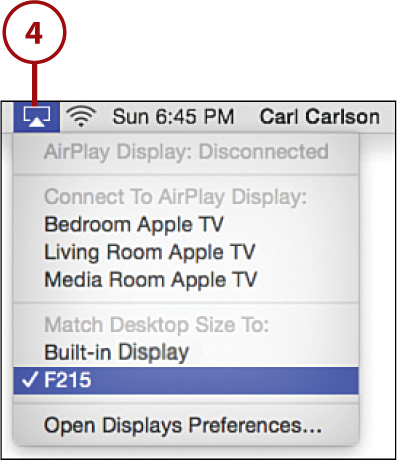
Using Mirrored Displays
When you plug another display into your Mac, it is initialized and activated as an extension to your desktop at the highest resolution it supports. If you’d prefer to mirror the content between your displays, do the following:
1. Click the display mirroring menu item in your menu bar.
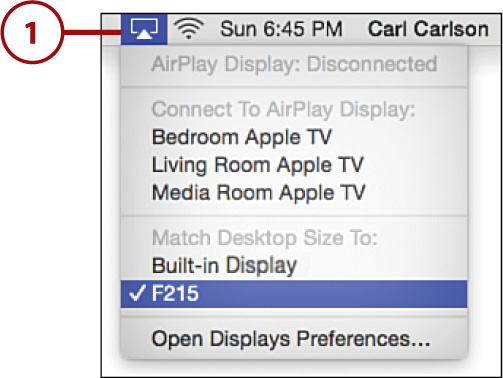
2. Choose Mirror Built-in Display. Your screen might go blank or flash for a moment.
3. Choose Extend Desktop from the menu to switch back to using two separate displays.
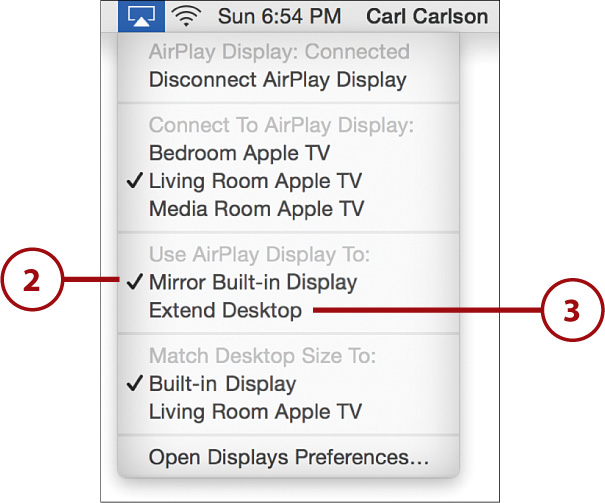
Note
If the external display is set as your primary monitor or cannot be adjusted to match your internal LCD, your Mac might instead change the resolution on its display to match the external monitor. This change reverts when you turn off mirrored video. To change the display resolution from the default, use the Displays System Preferences panel, as pictured in the previous section.
Connecting to an Apple TV (or Other Device) with AirPlay
Taking display connections to the next level, Yosemite makes it simple to wirelessly share your display with an Apple TV (2nd or 3rd generation). Couple an Apple TV with a monitor or a projector, and you have a wireless presentation system for classrooms, businesses, or just at-home fun.
AirPlay works in one of four modes: mirroring, desktop extension, video/image sharing, and audio playback. Before reading any further, make sure you’ve added the display mirroring menu to your display (if it isn’t there already) using the steps in the preceding section, “Adding the Display Mirroring Menu to Your Menu Bar.”
Although the Apple TV is the only AirPlay device that currently supports video, there are many speaker systems, amplifiers, and other devices (including Apple’s own AirPort Express) that can receive audio over AirPlay.
Old Mac? You Might Be Out of Luck!
Yosemite is only capable of mirroring and extending your display if you have recent Mac hardware. If you don’t see the mirroring menu (and you have an Apple TV), your Mac is likely too old to use Yosemite AirPlay features. That said, I strongly encourage you to check out AirParrot—a commercial piece of software that offers all the AirPlay features of Yosemite (and more) on any Mac (http://airparrot.com).
Mirroring Your Display to an Apple TV
To display your Mac monitor on an Apple TV, both devices must be turned on and connected to the same network. When things are powered up, follow these steps to mirror your display:
1. Click the display mirroring menu in the menu bar.
2. All available Apple TV devices are shown. Choose the one you want to mirror to.
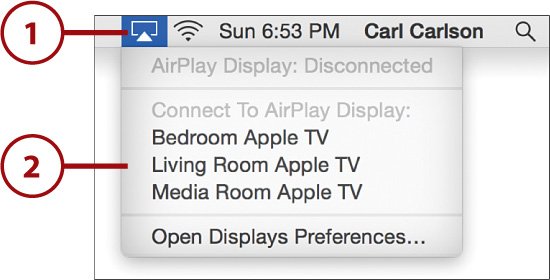
3. After a few seconds, your Mac desktop is visible on the display connected to the Apple TV via AirPlay (not shown).
4. To disconnect from AirPlay, choose Disconnect AirPlay Display from the mirroring menu.
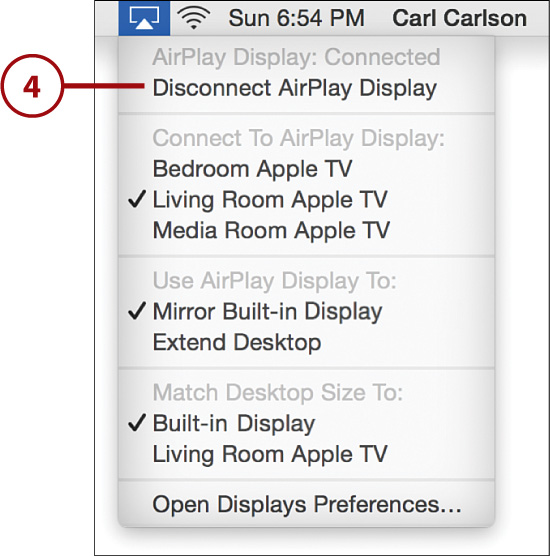
Mirror, Mirror on the Preferences Panel
You can also choose an AppleTV to mirror to directly from the Displays System Preferences panel. If an AppleTV is detected, a mirroring pop-up menu is added to the preferences.
Setting the AirPlay Apple TV Resolution
For the best mirroring performance, your Mac display should match the resolution of the display connected to the Apple TV—otherwise, your desktop will be enlarged and might look blurry. To adjust the resolution of the mirrored display, use these options.
1. Click the display mirroring menu in the menu bar.
2. Choose Match Desktop Size To: Built-in Display to scale the Apple TV image to match your Mac’s display.
3. Choose Match Desktop Size To: <AirPlay Device> to change your Mac resolution to match the resolution of the display connected to your Apple TV (this is the preferred approach).
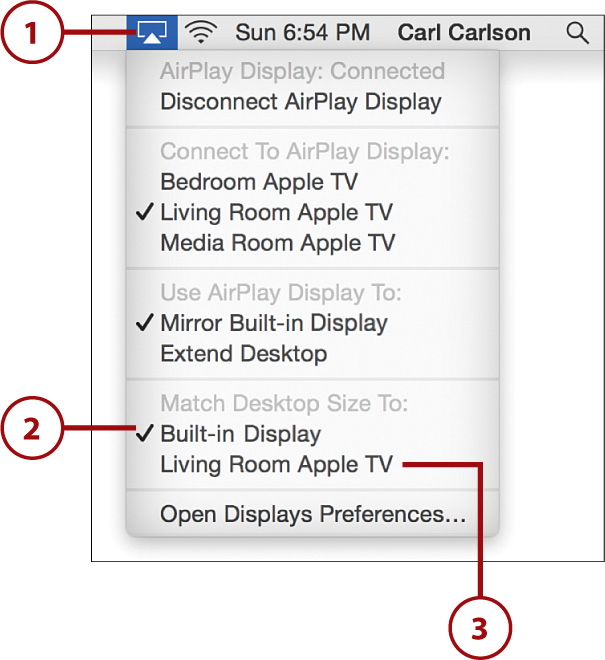
Extending Your Desktop to an Apple TV
In addition to mirroring, Yosemite actually enables your Mac to use an Apple TV as an entirely new monitor—extending your desktop as if you had plugged a new display directly into your computer!
1. Click the display mirroring menu in the menu bar.
2. All available Apple TV devices are shown. Choose the one you want to use as another monitor.
3. Choose Use AirPlay Display To: Extend Desktop.
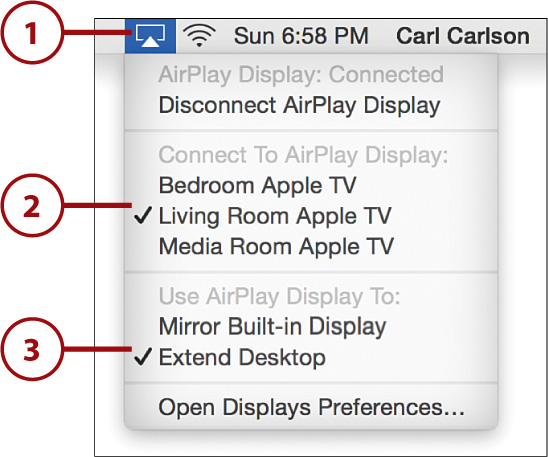
4. The Apple TV is added as an external display and can be configured using the Displays Preferences panel like any other display.
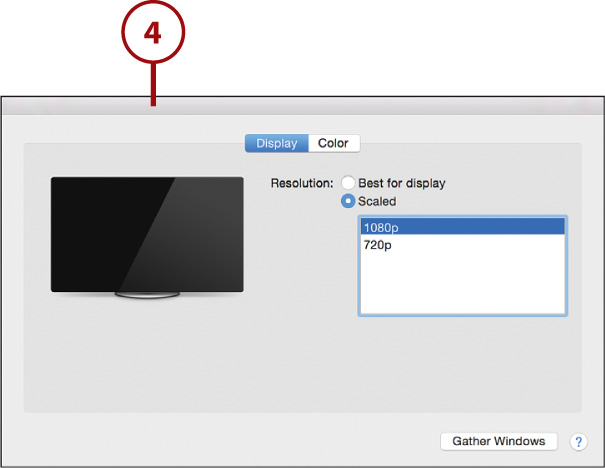
5. To disconnect from AirPlay, choose Disconnect AirPlay Display from the mirroring menu.
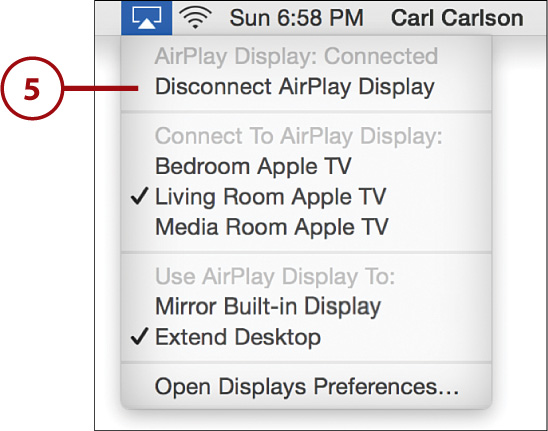
Sharing Multimedia to an Apple TV
In addition to acting as a monitor for your Mac, your Apple TV can also play video, audio, and other multimedia content (such as slideshows), if supported by your software. While viewing video, audio, or other multimedia content, look for an AirPlay icon, then, complete the following:
1. Click the icon to display and choose from any available Apple TV.
2. After choosing an Apple TV, the content that was playing on your Mac is automatically transferred to the Apple TV.
3. Choose Computer to return the display to your local Mac.
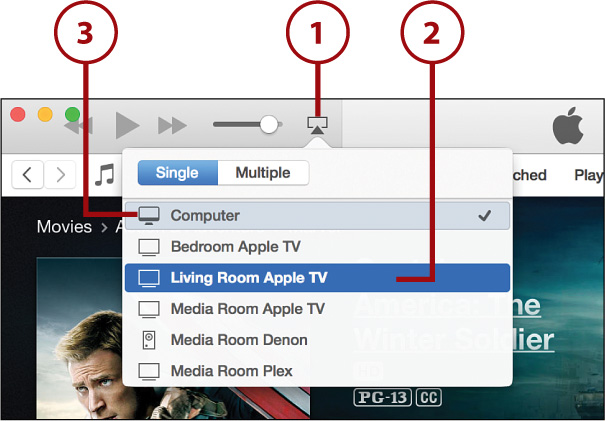
Sending System Audio to an Apple TV
Any application that outputs audio to your default system audio device can be sent transparently, via AirPlay, to an Apple TV. To send your system audio to an Apple TV connected to a sound system, follow these steps:
1. Open the Sound System Preferences panel.

2. Click the Output button at the top of the panel.
3. Choose the AirPlay device you want to use for audio.
4. Adjust audio and work with the device just like you would with your normal Mac speakers.
5. Close the System Preferences.
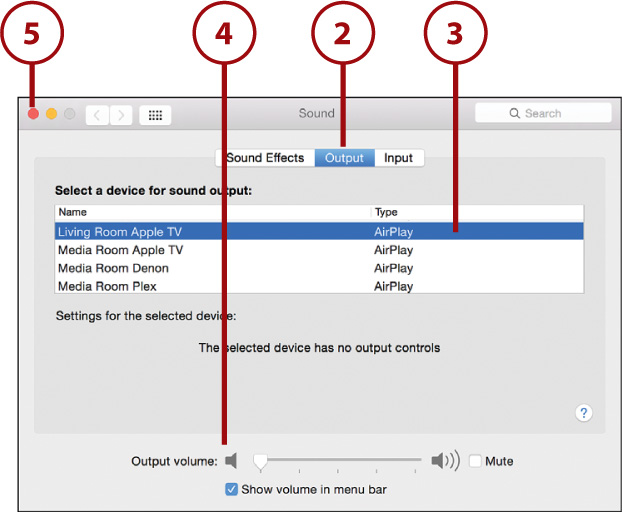
Connecting and Using a Printer
Out of the box, Yosemite supports a range of popular printers just by plugging them in. Occasionally, however, you might need to install a driver before you can successfully print. As with any peripheral that you want to use, be sure to read and follow the manufacturer’s instructions before proceeding.
Adding a Printer
Your Mac can connect to printers either over a network or via a USB direct connection. Regardless of the approach, configuration is straightforward.
Setting Up a USB Printer
To connect to a printer via a USB connection, set up the printer as directed by the manufacturer, then follow these steps:
1. Connect the USB plug from the printer to your Mac and turn on the printer. If the printer is auto-detected, it might prompt you to download software (not shown).
2. Open the System Preferences window and click the Printers & Scanners icon.
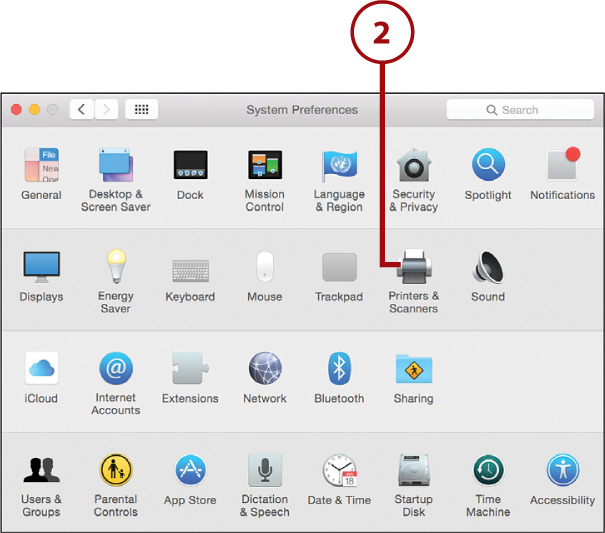
3. In many cases, the printer is detected and configured automatically and is immediately available for use. If this is the case, it is displayed in the Printers list, and you may close the Printers & Scanners System Preferences panel.
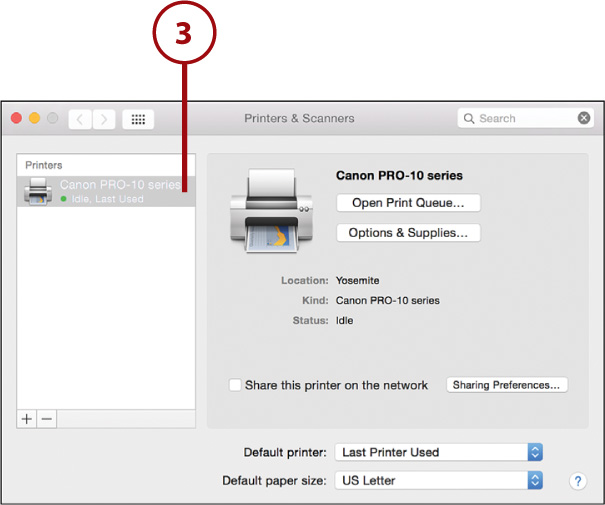
4. If the printer is not detected, click the + button below the Printers list and choose Add Printer or Scanner from the pop-up menu.
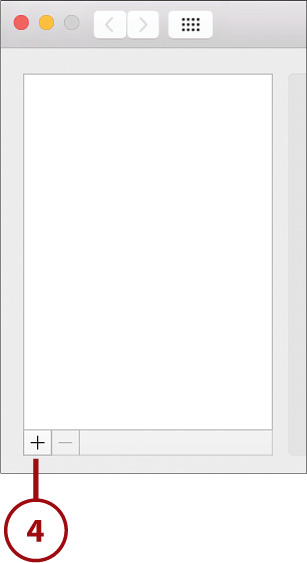
5. A window is shown displaying all of the available printers detected by your Mac. Choose the printer from the list.
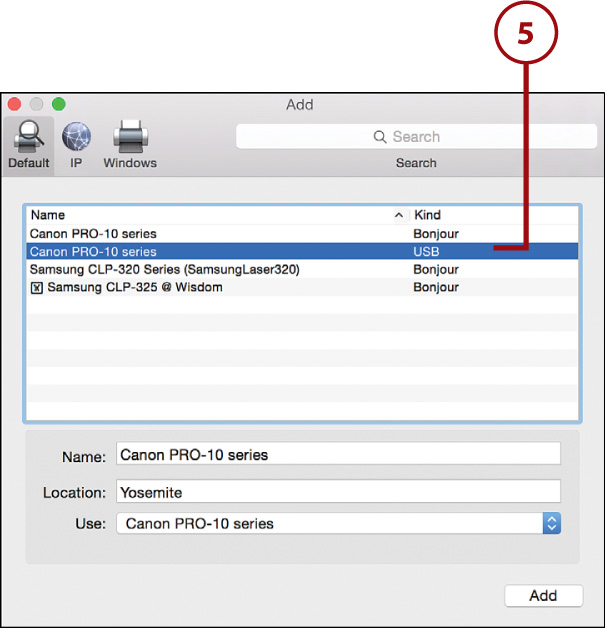
6. Your Mac searches for the software necessary to use the printer and displays the chosen printer name in the Use drop-down menu.
7. If the correct printer name is shown in the menu, jump to step 11.

8. If the correct printer name is not displayed in the Use drop-down menu, choose Select Software from the menu.
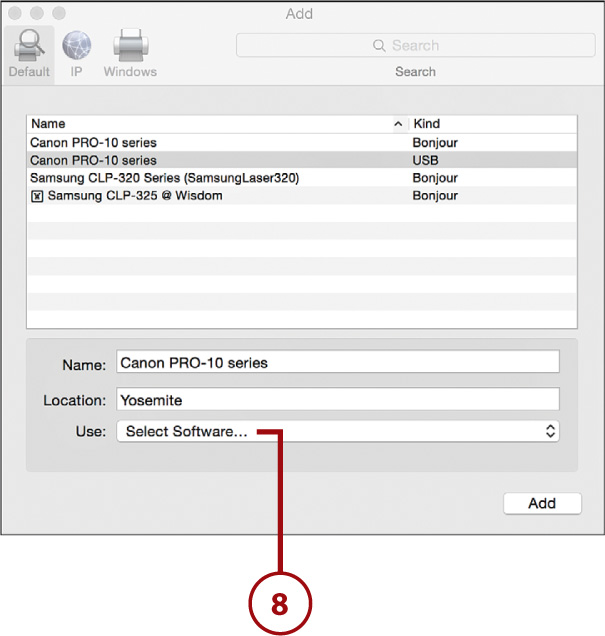
Setting Up a Network or Airport Printer
To add a network printer, follow the steps described in the Chapter 6 section, “Accessing a Network Printer.”
Airport-connected printers, even though they might not technically be network printers, are configured identically to network printers. Airport makes them available over Bonjour, a configuration-free networking technology developed by Apple.
9. A window appears that shows all the printers supported in Yosemite. Click your printer within the list.
10. Click OK.
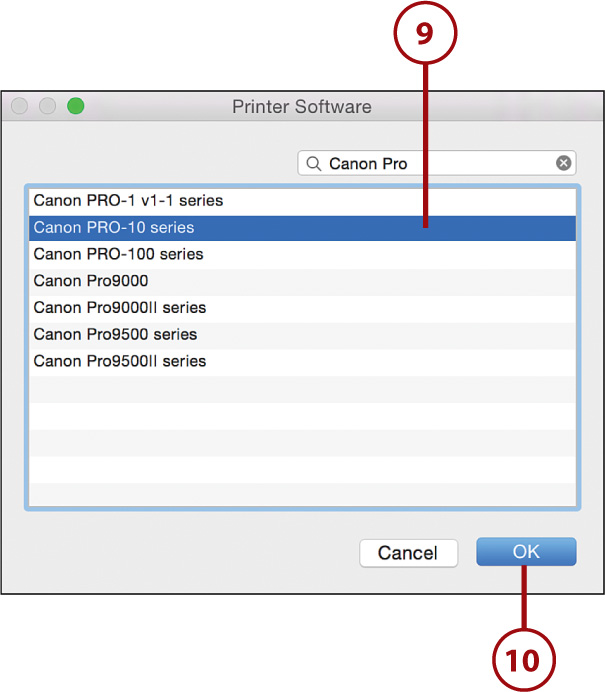
11. Click Add to finish adding the printer. If there are options (such as a duplexer) that your Mac can’t detect, it might prompt you to configure printer-specific features.
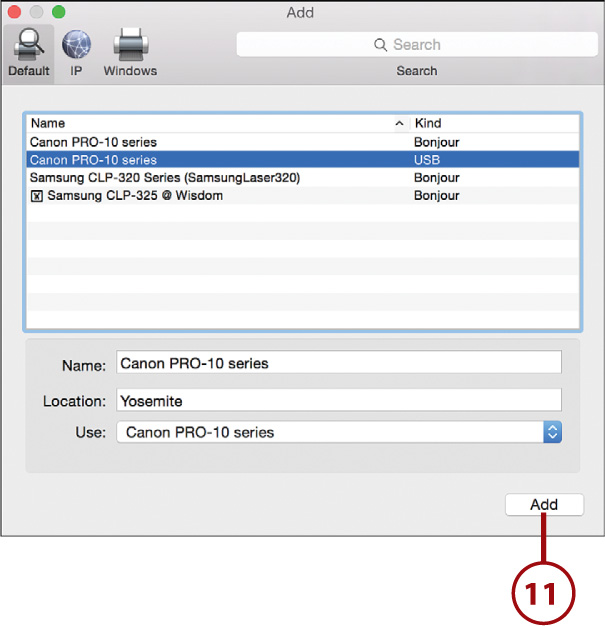
12. Close System Preferences and begin using your printer.
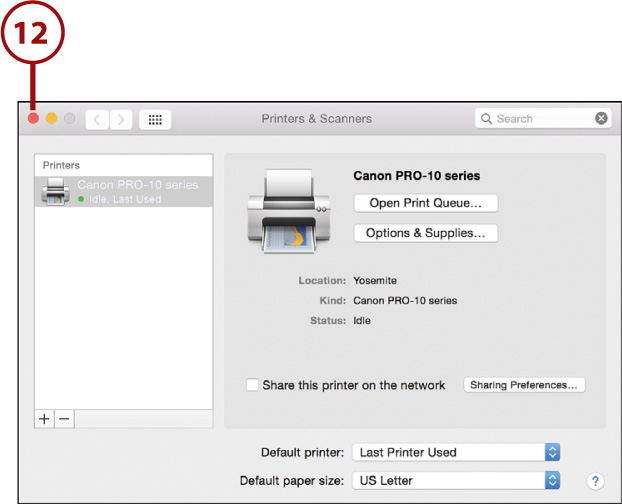
The Printing Process
The options available when printing can vary depending on the application that you’re printing from, but once you’re used to the process you’ll be able to find your way around any software’s printing options.
Printing to a Printer
To output to one of your configured printers, complete the following steps in the application of your choice:
1. Choose File, Print from your application’s menu bar.
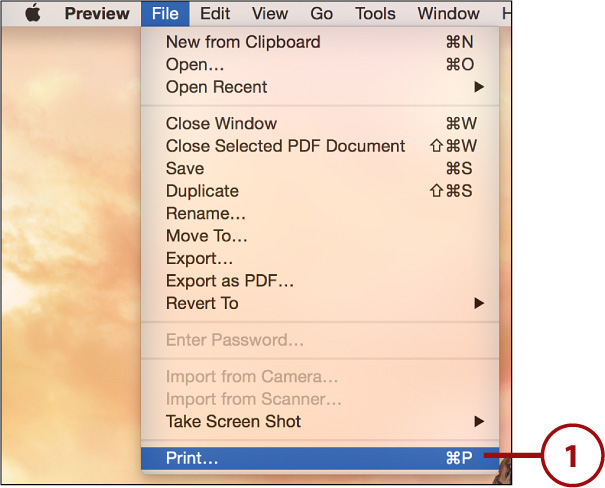
2. Click the Show Details button to display all the available options, if needed.
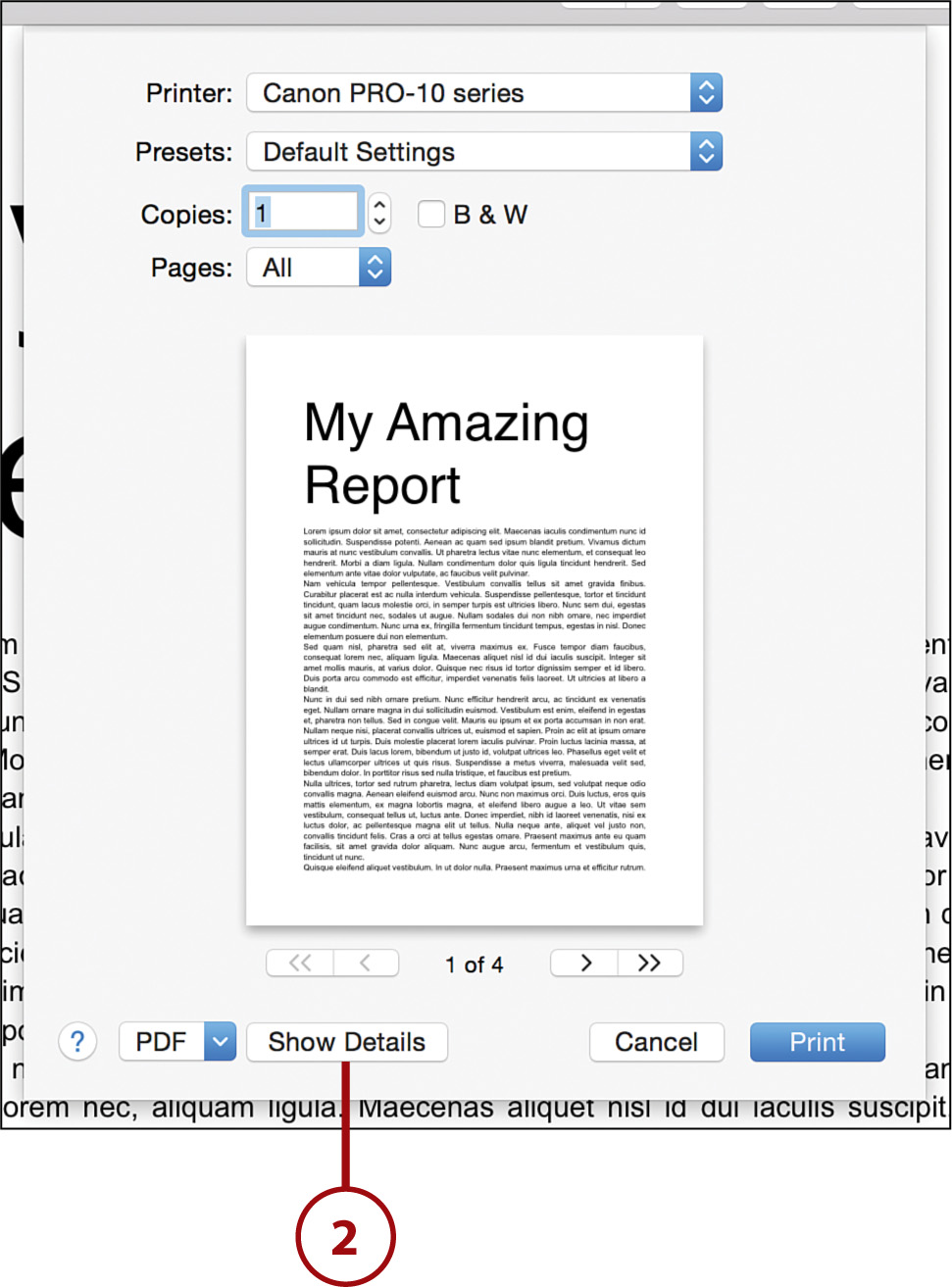
Where Is the Page Setup Option?
Apple has been working to streamline the printing process. In many applications, the Page Setup functionality has been combined with the standard Print function.
3. Select the printer you want to print to.
4. Set the number of copies and page range options.
5. Set the paper size and orientation, if desired.
6. Use the advanced printing options pop-up menu to choose specific printing options for your printer or options related to the application you’re using.
7. Review the results of your settings in the preview area on the left side of the window.
8. Use the controls below the preview to step through the pages in the document.
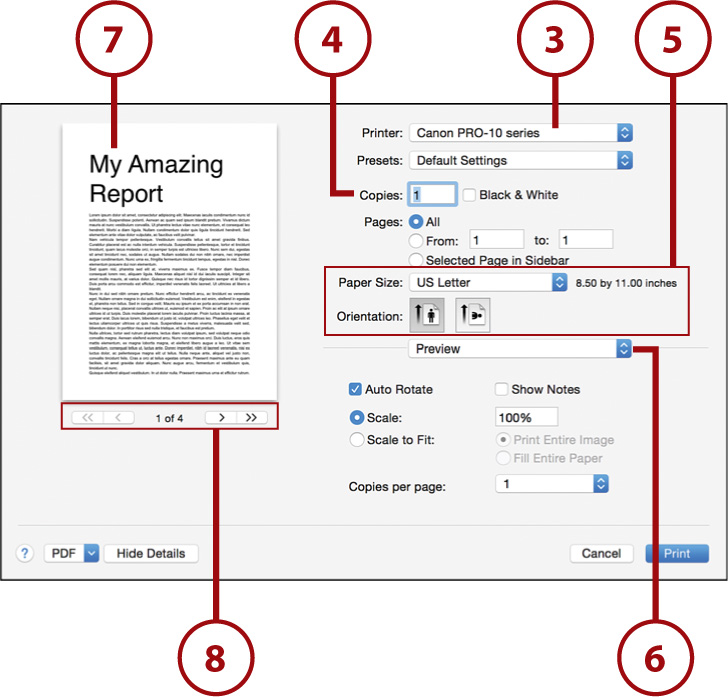
9. Use the Presets menu to save your settings if you want to recall them in the future.
10. Click Print to output to the printer.
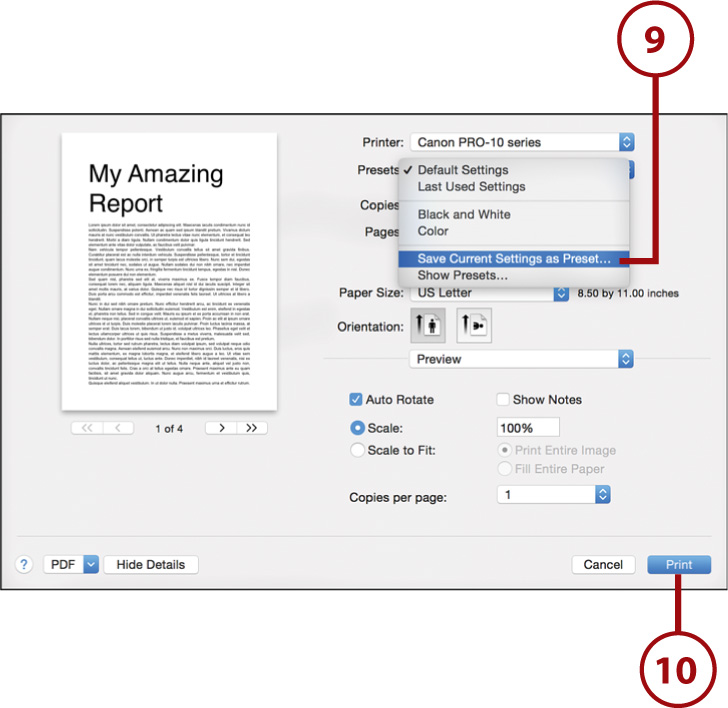
Printing to PDF
In addition to printing to a printer, you can print a document to a PDF, or open it directly as a PDF in Preview. To print to a PDF, click PDF and choose Save as PDF in the Print dialog box. To open the document as a PDF in Preview, choose Open PDF in Preview.
Connecting and Using a Scanner
Although it’s not a heavily advertised feature of Yosemite, the operating system can detect and drive a range of scanners without any additional drivers or software. This means that you can connect a scanner to your Mac and almost immediately begin scanning images.
Adding a Scanner
To connect a USB scanner to your Mac, complete any initial setup instructions provided in the hardware manual and then follow these steps:
1. Plug the scanner into your Mac and turn it on (not shown).
2. Open the System Preferences and click the Printers & Scanners icon.

3. The scanner, if supported, appears in the Scanners listing on the left side of the panel.
4. Choose the application you want to start when the Scan button is pressed on the scanner. I recommend Preview because it is a convenient application for working with images.
5. Close the System Preferences.

Network Scanners
Yosemite supports many network scanners, such as the popular Canon Pixma All-In-One line. For these devices, make sure you install any software the manufacturer provided and then follow the instructions for scanning with a wired scanner. OS X should automatically recognize the scanner, as long as you are connected to the same network.
Scanning in Preview
Preview (in the Applications folder, click Preview) serves as the image hub on your Mac. It views images and PDFs, and allows annotations, cropping, image rotation, and more. With Yosemite, it can also act as your scanning software. To scan an image directly into Preview, do the following:
1. Open Preview, or press the scan button on the scanner if Preview is set as the default scanning application.
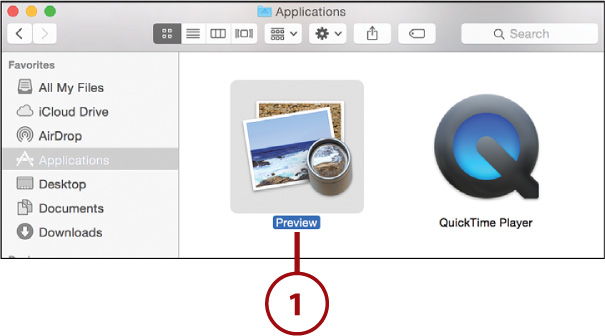
2. Choose Import from Scanner from the File menu.
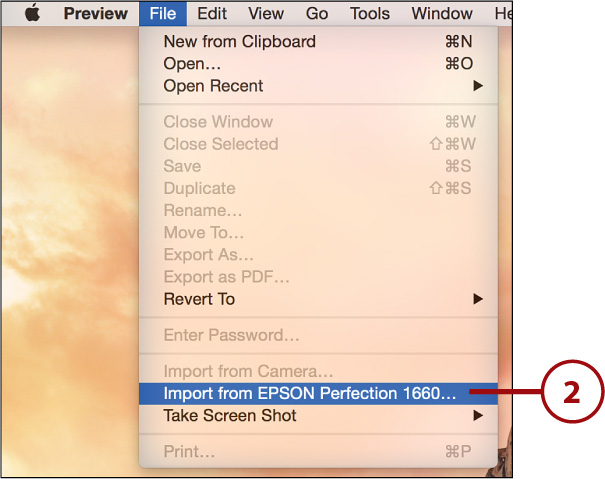
3. The basic scanning window appears. If you want to choose your scanning area or set the resolution, click Show Details and skip to step 8.
4. Use the pop-up menu in the lower-left corner to choose the size of the document you’re scanning.
5. Choose Detect Separate Items from the pop-up menu to automatically scan individual photos, pictures, and so on into separate images within a single scan.
6. Click Scan. Preview performs a detailed scan, and then opens the result in a new window, where you can save it if desired.
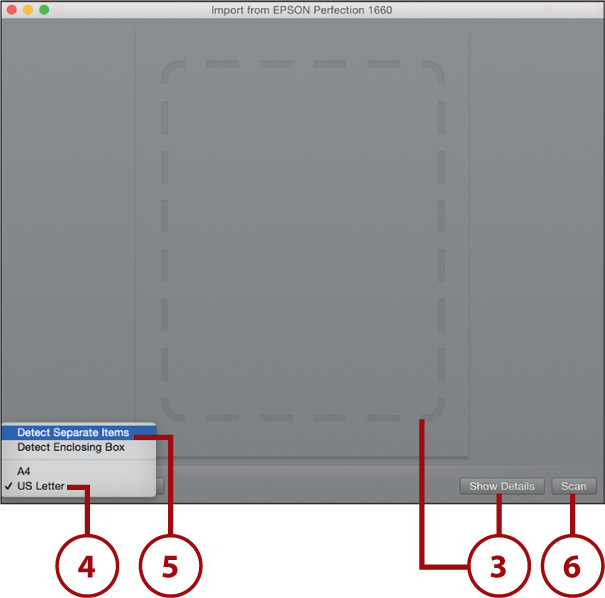
Originally, the Image Capture utility (found in the Applications folder) handled scanning in OS X. Yosemite has expanded that capability to Preview, but Image Capture is still available if you’d like to give it a try.
7. Repeat step 6 as needed for all of your images.
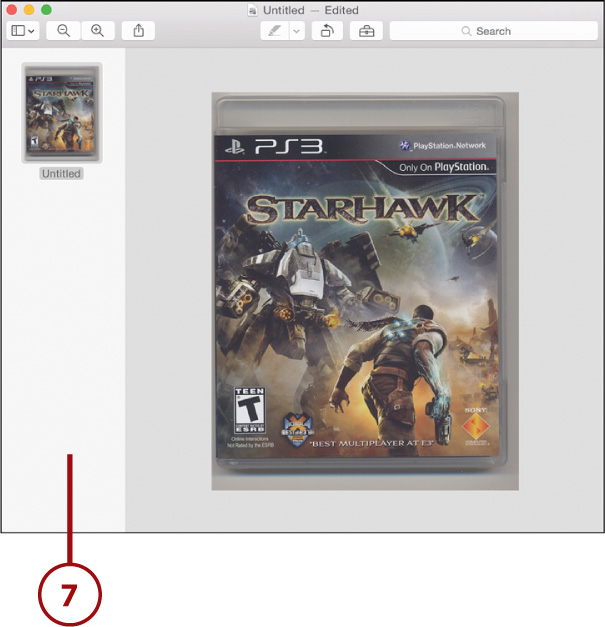
8. In detailed scanning mode, full controls for the scanner are shown on the right side of the window. Choose the scan’s resolution, size, orientation, and color depth.
9. Configure the format for scanned images.
10. Adjust any image filters and clean-up features you want to apply to the scan.
11. Click Overview to perform a low-resolution scan of your document and display it in the preview area on the left.
12. Adjust the bounding rectangle to fit your document. If you’ve chosen to detect separate items, you will see multiple bounding rectangles.
13. Click Scan to begin scanning.
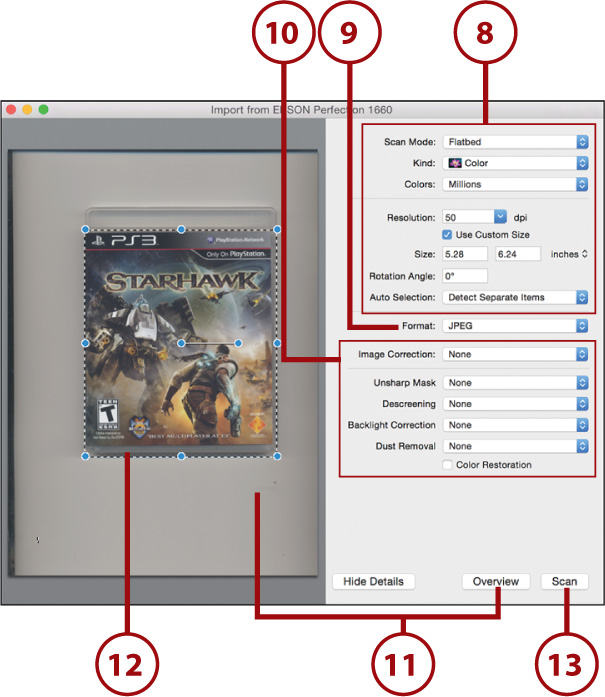
14. The result opens in a new window, where you can save it if desired.
